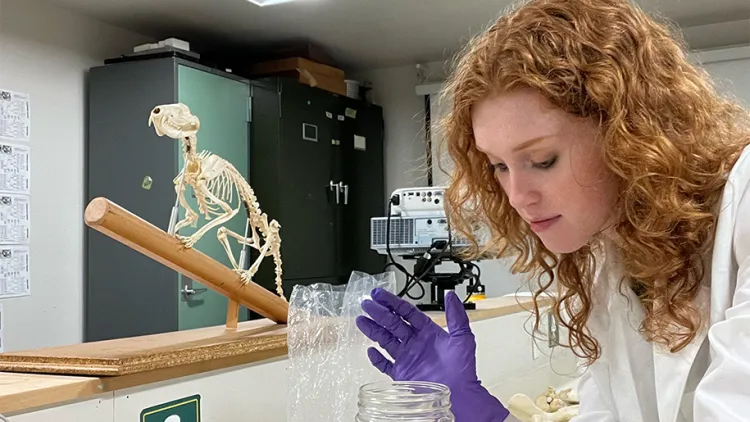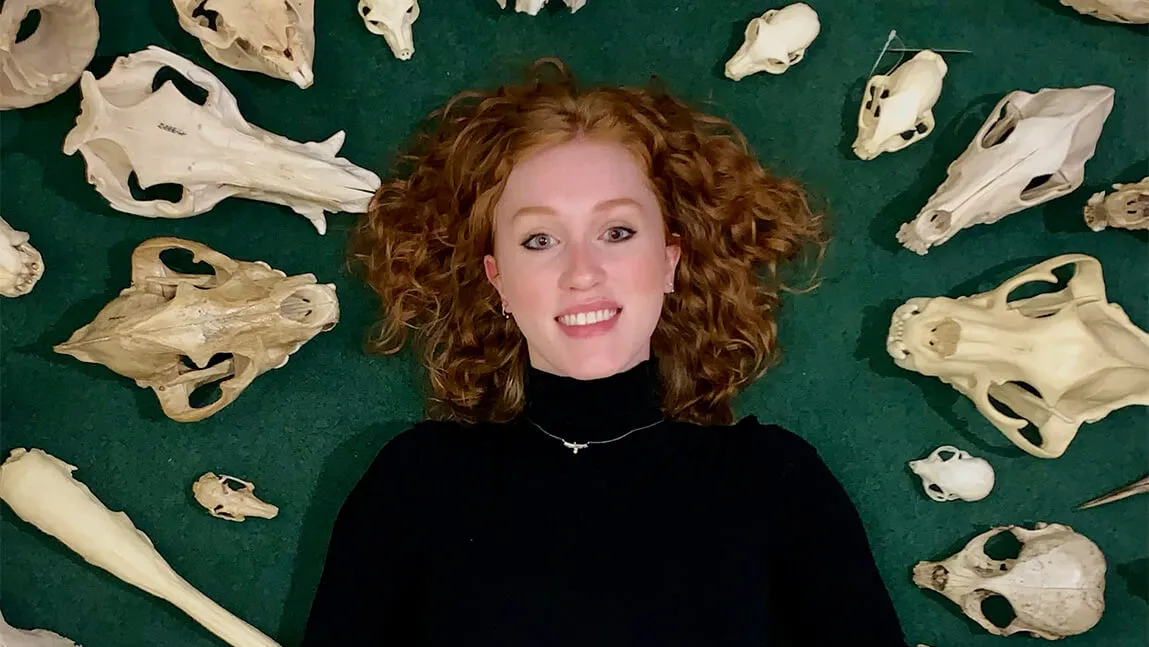Walking home one day during her freshman year of high school, Lily Duerr ‘24 happened across a cat skull. At that moment, her interest in bones “took off like a rocket and never stopped,” she says. Her personal collection now numbers around 50 skulls and countless other bones, fossils, and rocks—and she has become adept at articulating skeletons, a skill she employs frequently as the first student to manage the vertebrate teaching collection at the UVM Natural History Museum.
Duerr’s passion for the natural world began early. “I’m incredibly privileged to have parents who love the outdoors and never hesitated to bring me along on camping, fishing, and hiking trips,” she says. They also took her to the American Museum of National History in New York City every year. She was always most excited by the dinosaur exhibits and consumed all sorts of natural-science media and experiences. “I’m a dinosaur kid who never grew up,” she says.
A double-major in biology and geology, Duerr first learned of the teaching collection while working with specimens in biology lab. Curious to know if they had come from a bigger collection, so she did a little digging and eventually tracked down Professor Emeritus Bill Kilpatrick, Ph.D. He told her about the vertebrate teaching collection, still in boxes after being moved from Torrey Hall in 2017 following a roof fire. Intrigued, Duerr offered to unpack everything and catalog it.
“It took me about a month to unpack all the boxes,” she says. From there she organized the specimens by their scientific classifications and catalogued the collection. She discovered that many specimens were broken or dilapidated, so she also started doing some articulation repair. “My first skeleton was a chinchilla,” Duerr says. “It had some little broken parts that I glued back together with my very basic knowledge at the time.”
Before paleontology, Duerr had entertained a career in creature concept design—artwork that brings to life creatures for film and TV. “Paleontology makes sense with respect to those ambitions,” she says, “because that’s essentially what it is. You’re digging up these fossils and you have very little to go on and you have to infer what sort of habitat this animal lived in and how it acted and what it looked like, and so on.” To expand her articulation skills, she combined this design talent with classroom experience in comparative anatomy, looked at diagrams and videos online, consulted with Kilpatrick, and endured a lot of trial and error. In time, she was able to completely disarticulate, clean, repair, and re-articulate skeletons.
“Although she’s technically an intern, we all view Lily as a colleague rather than a trainee,” says Sara Helms Cahan, Ph.D., associate professor of biology and director of the museum. “The skills Lily has gained are applicable to many fields,” she adds. “She has developed the technical skills needed for museum conservation, taxonomy, and data science, and the professional experience required for project management and teaching.”
After working in the teaching collections for a semester, Duerr received the Larrabee Award from the UVM Biology Department, a research grant that allowed her to make working at the museum her primary job for a whole summer. Her research involved comparing two methods of degreasing, one of the steps in cleaning animal skeletons.
The grant also supported the creation of 3D models of small mammal skulls. “Initially, I tried a technique called 3D photogrammetry, which uses a digital camera to take many pictures of an object and digitally aligns them to create a 3D model,” Duerr says. But she had limited success with tiny skulls, so she used the rest of the grant to purchase a laser scanner. That proved a wise decision, as the device has allowed her to create detailed scans of even the smallest skulls.
During this time, Cahan asked Duerr to be one of the leads for a new museum internship. “Lily is a natural leader and was excited to take on as much responsibility as we could give her,” Cahan says. She adds that every intern who has worked with Duerr has not only learned a lot but has also felt supported and mentored throughout the project—so much so that they often stay on to continue the work after the course concludes.
Now in her senior year , Duerr continues to both advise interns and manage the teaching collection, a job that includes creating catalogs, acquiring new materials, conducting repairs, cleaning specimens, articulating skeletons, and more. Her advice to incoming freshmen? “Explore what interests you and make a niche for yourself,” she says. After all, the job she found at the museum didn’t even exist until she asked about it.

Duerr says that when she teaches articulation to interns, she emphasizes intuition as an extremely important skill. “I tell them that if it feels wrong, it is wrong,” she says. “But if it fits together and you sense it’s right, then it’s right.” She adds that articulation might seem intimidating at first, “but what you find as you start working with these things is that they actually really do fit together the way a traditional puzzle does.”
Duerr is currently working on a project at the Fairbanks Museum and Planetarium in St. Johnsbury, Vermont. According to Beau Harris, director of collections at the Fairbanks, Duerr has been cleaning and stabilizing a set of articulated skeletons purchased in 1892. “These skeletons have been used for a variety of educational purposes,” Harris says. “Over the years, they’ve become dirty and had some bones fall off or move out of place. Lily has been doing an amazing job on the project.”
Duerr has been traveling to the Fairbanks for a few days at a time and doing this work right out on the museum floor, “which is a lovely opportunity to interface with people,” she says. She adds that interacting with the younger generation has been especially rewarding. “One of the things that really excites me about paleontology is its ability to get young children interested in the sciences,” she says.
Working within the framework of a broad-based liberal-arts education has allowed Duerr to cultivate two other passions, art, and music, as well. In addition to taking a couple of visual arts classes, she takes voice lessons every semester and is a member of the Catamount Singers. “I need the artistic outlet,” she says with a laugh.
After graduation, Duerr intends to attend graduate school to earn a Ph.D. in vertebrate paleontology, fulfilling a dream sparked when she discovered that first skull all those years ago. “I’m always excited about dinosaurs,” she says. “I’m always excited about the natural world.” It’s clear that this passion for exploring and restoring relics from the past has already begun to serve as a stepping stone to a bright future.
